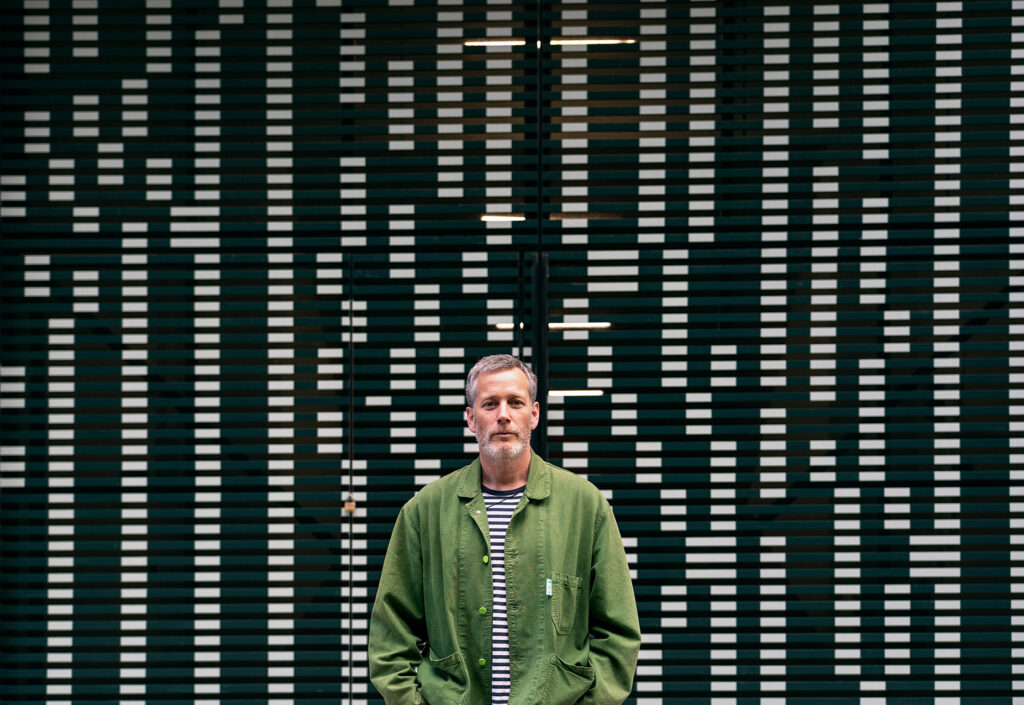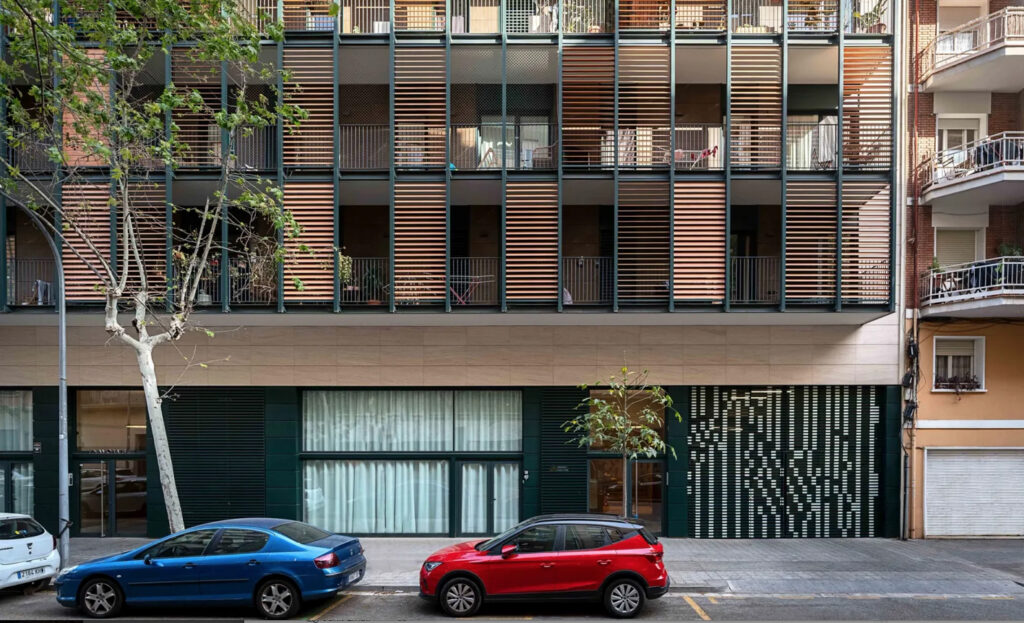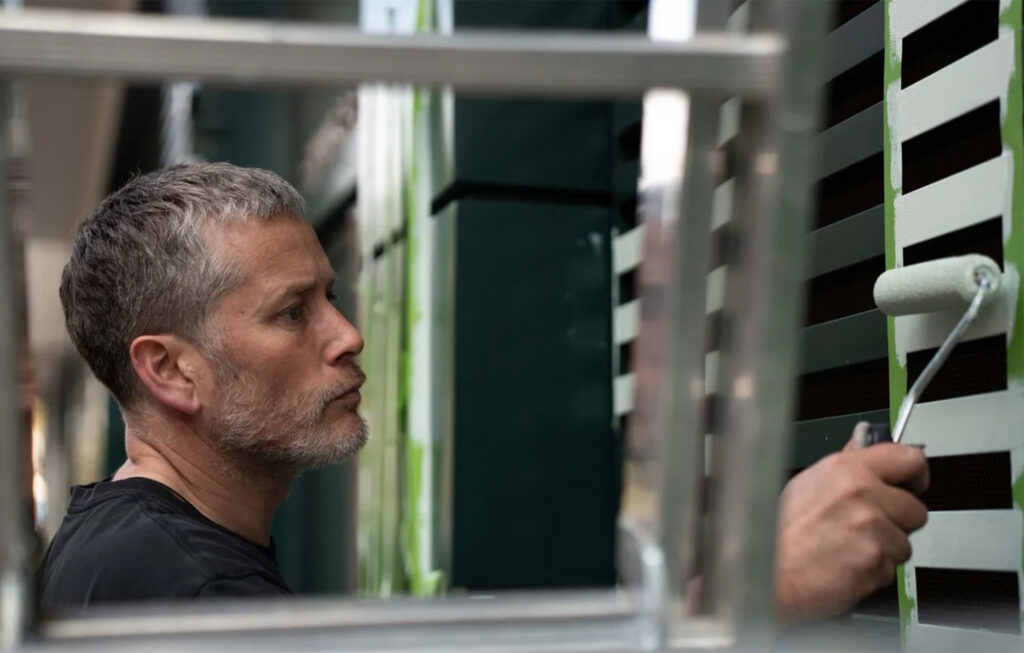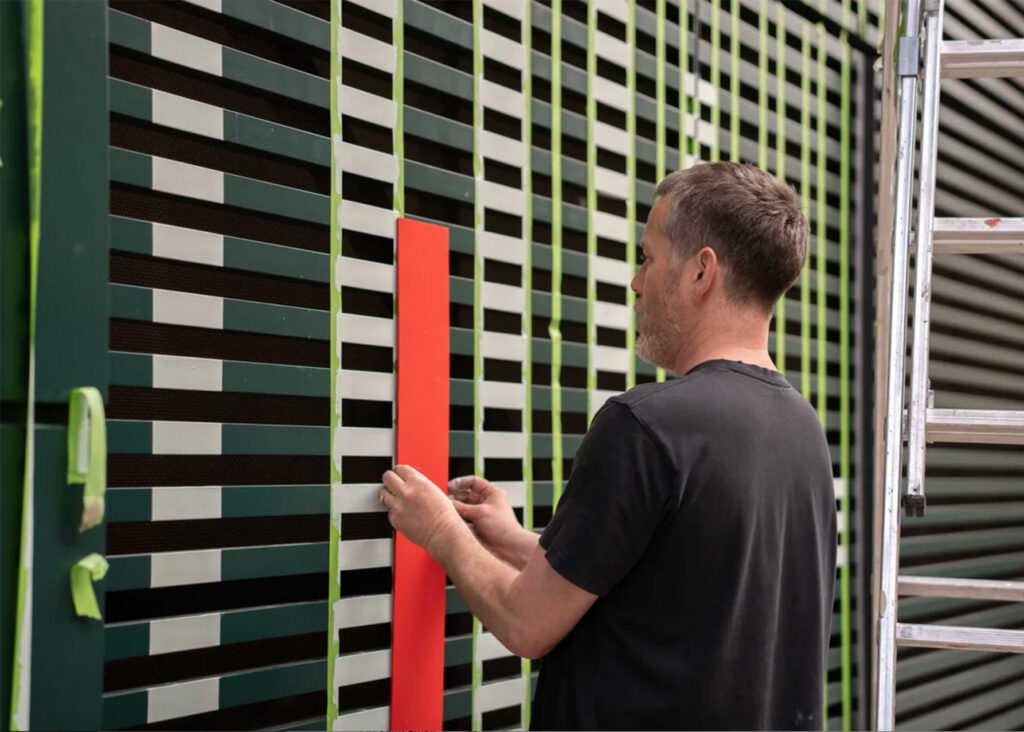The mural at 40 Enamorats Street in Barcelona is a subtle and elegant piece that creates a visual dialogue with the building’s architecture, drawing inspiration from its colours and diagonal shapes that reflect both the structure of the Eixample district and the nearby Diagonal Avenue. Created by Cristian Zuzunaga, the work explores the intersection of digital grids and urban space, bringing rhythm and harmony to the façade like a musical composition. This project was commissioned by Xavier Franquesa from il.lacions gallery, with the support of NN Group, for their NN Wallery project, who together champion the revitalisation of urban spaces through contemporary art. Thank you for this incredible opportunity.
GRUP NÚÑEZ I NAVARRO
INTERVIEW / Cristian Zuzunaga – NN Wallery – Enamorats, 40
BETWEEN DIGITAL AND ANALOGUE: A SEARCH FOR IDENTITY THROUGH ART
The artist Cristian Zuzunaga stars in the 33rd intervention of the
NN Wallery project in Barcelona.
Cristian Zuzunaga has spent his entire life exploring the boundaries between digital and analogue, urban and natural, personal and collective. His work is a constant reflection on identity, environment, and scale. From his studio in Bristol, United Kingdom, and with an international career that has taken him to London, New York, and Barcelona, among other cities, Zuzunaga transforms elements as seemingly simple as a pixel or a grid into symbols of universal connection. We spoke with him about his beginnings, creative evolution, and his urban art intervention for the NN Wallery project.
A journey between cultures, cities, and scales
Cristian Zuzunaga’s passion for urban art was born in his childhood, while observing Miró’s mural at Barcelona airport. “I was struck by its scale, the colours… later I understood its meaning,” he recalls. His education was not linear: he worked as a model between 1996 and 2001, a period that allowed him to live in cities such as New York, London, and Paris, and observe how art dialogues with urban space.
“In New York, I discovered giant-scale murals, many of which were advertisements but painted by hand, with impressive photographic quality,” he says. In London, in 2001, discovering Banksy left a deep mark on him. “It was a different kind of urban art, more direct, with a message, that spoke to the environment.” It was there he decided to study at the London College of Printing, an institution that allowed him to explore his interest in typography, architecture, and philosophy. “I became obsessed with the idea of what attracts us to cities, how they function as organisms,” explains the artist. This reflection led him to search for the basic units of visual language: the brick in the city, the grid in typography, the pixel in digital.
An identity built from mixture
With a Peruvian father and Catalan mother, Cristian says he does not feel defined by any nationality; his feeling of not belonging became a driving force of inquiry: “I wanted to understand what unites us as people beyond gender, race, or skin colour.”
He found his answer in geometry. “The grid allowed me to build a universal language,” affirms Zuzunaga. Through techniques such as screen printing, letterpress, and photography, he developed work that mixes analogue with digital, handcrafted with conceptual. “There has been a coherent narrative since I started: everything revolves around the grid and the square, their power to generate order and emotion,” he confirms.
From pixel to mural: back to the street
For years, Zuzunaga’s work focused on the digital field. “When the pixel entered my life, it was a revelation,” he explains. He founded his brand – “Zuzunaga” – collaborated with textile brands, and applied his visual language to multiple media. But over time, and especially after the pandemic, he felt the need to return to the origin: the tangible.
“I consciously decided to step back, because for me, art must be physical. The urban environment is real. The digital is mental,” he affirms. This return to the physical culminated in the creation of Frankenstein Press, a workshop in Bristol with restored century-old machinery. “We seek to heal through the printing press, to reconnect directly with the community,” he says about this new vital chapter.
Urban art that transforms the city
This vision found resonance in NN Wallery, the artistic project by Grup Núñez i Navarro to revitalise spaces through urban art. “I grew up seeing Grup Núñez i Navarro buildings on every corner of the Eixample,” he explains. Participating in this project was also a form of reconciliation with Barcelona, a city that is part of his artistic identity. His mural at number 40 Enamorats Street in Barcelona was a nod to that complex relationship. “I wanted to create a work that spoke with the building, that had rhythm, like a piano. Something subtle, serene, elegant,” he explains. The colour palette, inspired by details of the building itself and the diagonal forms, refers both to the Diagonal Avenue and the structure of the Eixample district. “It’s a mural that wouldn’t work anywhere else. It only makes sense there,” assures the artist.
Art, technology, and a full life
Zuzunaga advocates for art that intertwines digital and analogue but always centred on the human being. “For years I believed art should use contemporary technology. But over time, I realised that what matters is not technology itself, but what it says about us.”
For him, travelling, reading, and observing are constant sources of inspiration. He is also convinced that art and design can transform lives: “We are all born creative. But most forget it. Art is essential for a full life.” And when asked what he would recommend to anyone wanting to discover a different Barcelona, his advice is clear: “Walk. Leave the tourist circuit. Discover the neighbourhoods. Observe. There lies the unique.”




